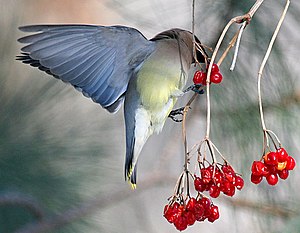 Image via WikiThe Cedar Waxwing (Bombycilla cedrorum) is mostly frugivorous or fruit eater. Berries play a large role in the cedar waxwing's breeding, social and migratory behavior. Native berry-producing trees and shrubs planted in your yard can attract waxwings and will often encourage them to nest in your area. Some plants that bear small fruits are dogwood, serviceberry, cedar, juniper, hawthorn, and winterberry.
Image via WikiThe Cedar Waxwing (Bombycilla cedrorum) is mostly frugivorous or fruit eater. Berries play a large role in the cedar waxwing's breeding, social and migratory behavior. Native berry-producing trees and shrubs planted in your yard can attract waxwings and will often encourage them to nest in your area. Some plants that bear small fruits are dogwood, serviceberry, cedar, juniper, hawthorn, and winterberry.Our Wild Birds Unlimited - East Lansing store is surrounded by a variety of crab apple trees that ripen at different times of the year and attracts flocks of waxwings year-round. Waxwings also catch and eat flying insects on the wing or glean vegetation for crawling bugs.
You might hear the waxwings before you see them. They have a very distinctive thin, high-pitched warbled "zeee" or "zeeet" call that is hard to forget. They are very social and usually fly in large flocks and often nest in loose clusters of a dozen or so nests.
 Image via Wikipedia
Image via WikipediaFemale waxwings do almost all the nest building. Construction of the bulky cup-shaped nest takes a week and may require more than 2,500 individual trips with twigs, grasses, cattail down, blossoms, string, animal hair, and similar nesting materials.
Usually 5 or 6 eggs are laid and the female incubates them for two weeks. The eggs are bluish grey with irregular, dark brown splotches. Both parents feed the young which fledge or leave the nest after two weeks.
The nestlings stay close to the nest and are fed by the parents for another 6 to 10 days, but after that, they split off to join a flock of other juvenile birds.
The name "waxwing" comes from the waxy red secretions found on the birds’ wingtips. The red waxy drops are actually flattened extensions of the feather shafts colored by astaxanthin, a carotenoid pigment. Both males and females have the red waxy tips on their wings but only after their second fall. The older the bird, the more showy the red tips.
Studies show that the birds only mate with birds within their own age range and the amount of wax on the wing may be how the birds determine who is in their mate group.
Related Articles:

No comments:
Post a Comment